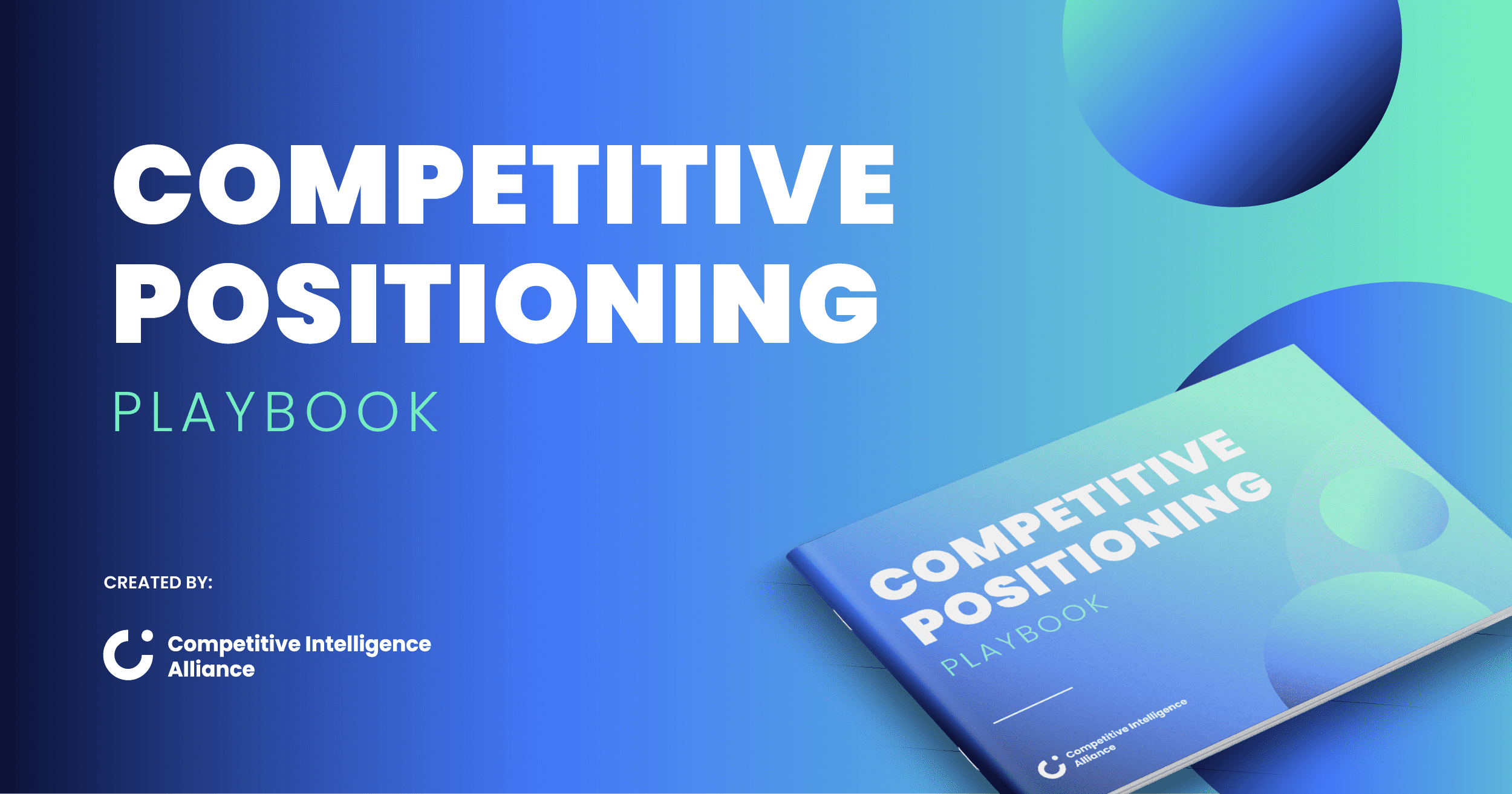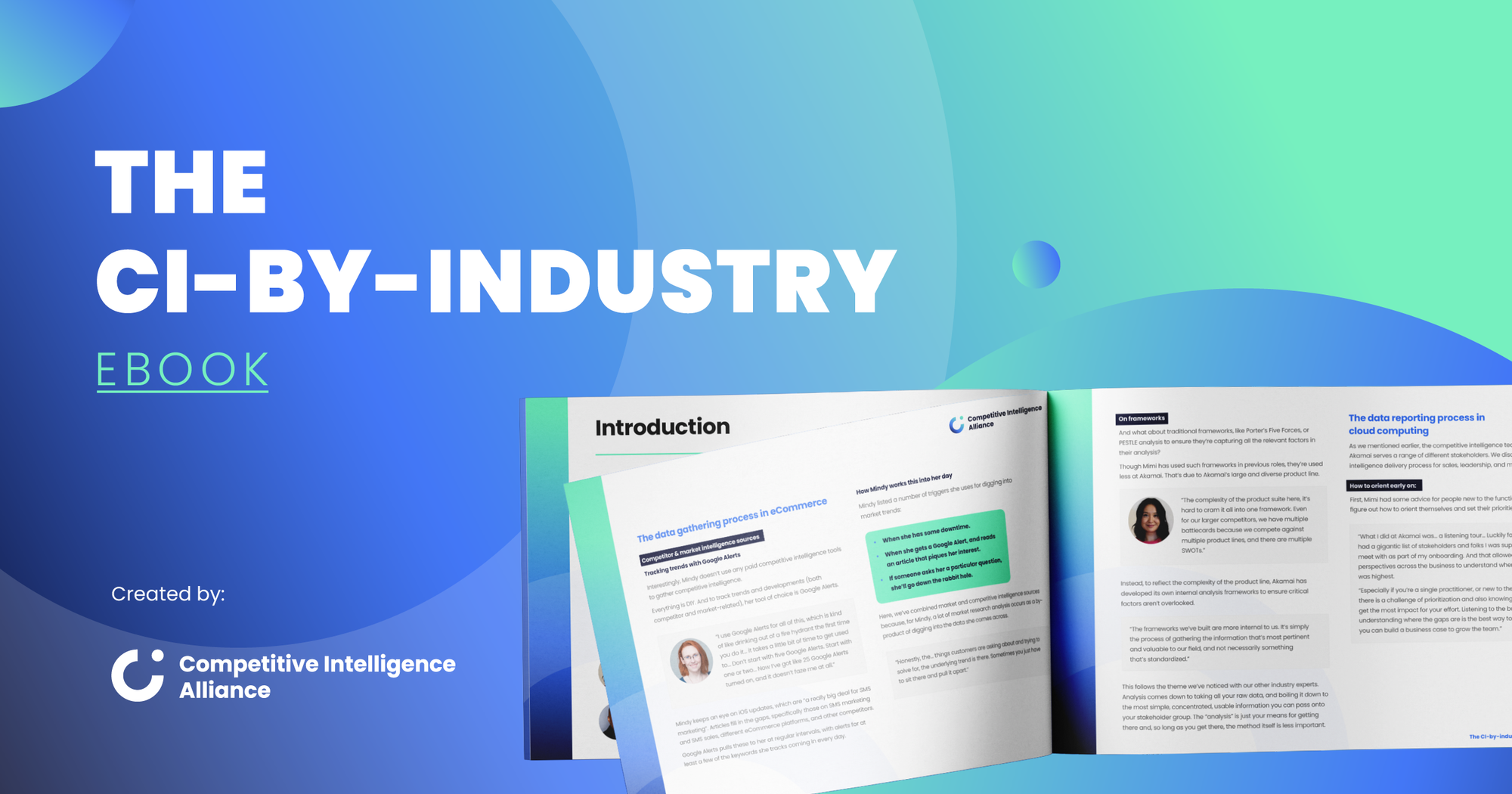If you want to stay ahead of the pack, you have to understand your rivals. But how can you use competitive intelligence to craft a winning strategy? You’ve come to the right place to find out!
Get ready to learn…
- What role competitive intelligence (CI) should play in your positioning campaigns.
- How to leverage competitor insights for major product and pricing shifts.
- How to get started with CI.
- How to use SEO and SEM data to exploit unique competitive advantages.
- And much more.
Whether you're a dedicated CI pro or a product marketer (PMM) juggling competitive intel with your other duties, you'll walk away ready to outsmart your fiercest competitors.
Listen here 👂
The role of competitive intelligence in positioning
Competitive intelligence lays a strong foundation for differentiated competitive positioning. It gives us a clear sense of common language, product categories, and problem/solution spaces others play in.
If you’re a product marketer focused on positioning, your job is to understand where competitors play and then use that knowledge to differentiate your product. It’s vital to layer in messaging about the unique value you provide to your target customer, too. Distilling your core competitive advantages down to a single positioning statement can do wonders for clarifying your thinking around positioning.
However, you can’t just set and forget your positioning. It needs to be regularly revisited and refreshed, much like CI toolkits or battlecards do.
So… how often should you revisit your positioning?
There’s no one-size-fits-all rule. It depends on your industry, competitiveness, product changes, and target customers. However, as a rule of thumb, to mesh competitive and positioning refreshes, I tend to advise teams to refresh competitive research quarterly to stay current. You can tie this into a positioning and messaging refresh if necessary.
The scope of positioning and messaging refreshes varies. Smarter than making assumptions is A/B testing two homepages with different messaging to find what resonates.
Ads are another fantastic testing ground for messaging. You can continuously track conversion rates, and use those learnings to inform broader quarterly refreshes.
How much input PMM has into messaging channels matters too. The homepage is what most new customers see first, so strong positioning there is key. Then it’s vital to connect the dots to other touchpoints like ads, and events that inspire homepage visits.
If your organization has sales reps or support staff, you need to enable those teams to test messaging and provide feedback, too. Their insights are invaluable.

No product is created in a vacuum
The Competitive Positioning Playbook teaches you...
👷 How to blend CI and customer research for a rock-solid positioning strategy.
🙅♀️ The three steps you must not skip in crafting competitive positioning.
🪛 A top-to-bottom tear down of the positioning process, and how CI fits in.
🏹 How to use competitive positioning to shatter your org’s revenue ceiling.
Interested? Click the button right now to check it out.
Leveraging competitor insights for major product and pricing shifts
Competitive intelligence’s role in shaping product marketing strategies isn’t limited to positioning. When I led product marketing at Unbounce, I oversaw the repositioning of the product from a landing page builder to a conversion intelligence platform. I also navigated two pricing changes. Competitive intelligence guided these projects.
Competitive and market intelligence were huge drivers for Unbounce's strategic decision to build a new category, with all the pricing, messaging, and other changes that entailed. Let me rewind a little to show you what I mean.
Some context…
Many moons ago, Unbounce was first to market with its user-friendly, no-code landing page builder tailored for marketers and designers. But fast-forward a decade, and every SaaS product category was swamped. Landing page builders were suddenly a dime a dozen, especially with full website builders emerging. There was a strong need to differentiate; competitive intelligence helped us realize that.
Thanks to our intel, we understood the core value propositions of landing page builders. Onto that, we layered-in the customer needs existing solutions weren't addressing well. Customers wanted clicks and conversions, not just landing pages. Knowing that informed our decision to create a conversion intelligence platform, rather than just another landing page builder.
Our new messaging, our understanding of our customers’ needs, and the value proposition we wanted to chase, all of these guided the roadmap for our platform. All of that stemmed from our foundational customer, market, and competitor intelligence.
The real value of competitive intelligence in re-positioning
Competitive intelligence not only informed our pricing strategy by revealing competitors' existing approaches and pricing models – it also highlighted unmet customer needs we could differentiate on. For us, that meant connecting the dots between our unique value prop (driving conversions) and our pricing strategy and structuring our pricing tiers accordingly.
While competitive pricing was a consideration, value-based pricing aligned to our competitive differentiation was the main strategy at Unbounce, rather than simply matching competitors.

CI-by-Industry eBook
Download your copy to learn...
- 😰 Why field intelligence can be dangerous, and how to use it the right way. (Page 24)
- 🙅♂️ Why you should think twice before having reps from this team on a win/loss call. (Page 24)
- 🤖 The truth about automation, and how much time tools can really save you. (Page 22)
- 🤯 The surprising key skill every one of our industry experts said was crucial for CI success. (Page 66)
How to get started with competitive research
Whether you're a dedicated CI professional or a product marketer with CI responsibilities, the number one thing you need to know is your customers. In this case, your internal teams are your customers.
Start by talking to your stakeholders to uncover their pain points, rather than making assumptions about what kinds of intel they need. Identify where your knowledge can fill gaps and drive new value across the organization.
For example, perhaps your current SEO strategy overlooks competitor keyword gaps – capitalizing on this could unlock new organic traffic, inform content architecture, and inspire fresh brand campaigns.
By leading with curiosity about internal customer needs, you can continually evolve CI's value proposition. Discover where you can uniquely contribute based on your organization's specific gaps and priorities. Then apply your CI expertise to pragmatically and innovatively solve those needs.
What makes a successful CI practitioner?
The most impactful CI practitioners are those who intimately understand the strategic objectives and blindspots across marketing, product, sales, and leadership. They then laser-focus their efforts on delivering competitive insights tailored to helping those teams win, rather than just generating reports and data for data's sake. It's about creating value.
Once you know what your stakeholders need, how can you go about gathering those all-important competitive insights? Competitor websites are usually a product marketer's first port of call – but you shouldn’t stop there.
Go-to sources of competitor intelligence
Whenever I’m onboarding new PMMs, I provide a competitive intelligence handbook to set up that foundational awareness during their first week. This includes tips like…
- Set up Google keyword alerts.
- Sign up for competitor newsletters.
- Sign up for trials of your competitors’ products – using your work email for the sake of transparency.
- Keep a close eye on the pricing pages of companies in similar industries to your own. You can even create alerts for changes using tools like Visualping.
As a PMM, you want to be able to set and forget alerts where possible. That’s a great way to stay on top of changes and trends in your industry.
Then for strategic initiatives like pricing overhauls, you’ll want to dig deeper – visiting websites, talking to customers who've used competitors, and closely following online user communities.
User communities are goldmines for unfiltered feedback and sentiment. Check competitors' own community platforms of course, but also Reddit, Facebook groups, forums, etc. Following influencers in the space also means you’ll be one of the first to hear about price changes or any dissatisfaction with the product.
Hearing from users is always impactful. We sometimes overlook just how many vibrant online communities exist to tap into the voice of the customer.
Finally, don't forget to leverage your internal sources of competitive intelligence for maximum efficiency.

How to hone your SEO strategy
One of the most useful yet least talked-about avenues of competitive research is search engine data, but how can you go about exploiting it?
The good news is you don’t need to be an SEO expert or have a huge budget to get started – there are a ton of freemium keyword research tools out there that make keyword research simple and cost-effective.
Start by asking questions:
- What language do your customers use to describe your software category?
- What phrases do they use when searching for better solutions?
Applying that customer-centric lens to keyword research should provide you with an initial list of top-quality questions to answer with your content.
It’s also a good idea to find out which terms your competitors are trying to rank for. Again, this is something many SEO tools can help you with. Better yet, you’ll want to identify untapped keyword opportunities your competitors haven't claimed yet, where you can get a first-mover advantage for your brand.
Next, I’d recommend mapping out an SEO playbook, which will define the content types you’re going to create. These could include long-form guides and whitepapers that Google's helpful content updates will favor, or glossary pieces to strategically target keywords.
And, of course, you can’t just set and forget your SEO work. It’s vital to refresh existing content by layering in new competitor insights and targets. This is a great way to stay ahead of the game without investing tons of time and money.
While product marketing may not fully own the execution of your SEO strategy, providing this competitive expertise and customer perspective is crucial.
Using CI to address new threats
Competitive intelligence projects can take many forms, depending on the situation and your organization’s needs. However, there are three primary types of CI initiatives you're likely to encounter over the course of your career:
- 🏃♂️ Reactive projects: These come about when leadership, sales, or marketing come to you saying, “Who are these new players? We need to know everything yesterday.” This urgent need for competitive insights is usually driven by sudden competitive threats or deal losses.
- ♟️ Strategic initiatives: These are longer-term projects to redefine your market positioning and strategy. They require more investment of budget, time, and resources to contribute meaningful competitive research and analysis.
- 🐲 Myth-busting: In some cases, you'll join an organization that believes they have no competitors and don't need CI. You have to dispel those myths and build an evidence-based case for why competitive intelligence matters.
Where I had most success...
The most success I've had has been rapidly spinning up effective reactive CI programs. At a previous company, we were previously first-to-market but then seemingly overnight faced five or six very capable, targeted new competitors. I could feel the internal anxiety brewing around them, even if no one was talking about it.
I proactively went to leadership, deprioritized other projects, and said, “Give me two weeks to get us up-to-speed on the full competitive landscape.” I scoped the work upfront, outlined deliverables, and got buy-in for that short-term project.
The competitive intelligence I provided in those two weeks set us up for about a year and a half. It comprehensively charted the new competitive environment, and gave us a strategic response plan – all from a rapid reactive project initiated due to an urgent internal need.
This is the key...
The key is to make the hard decision to fully prioritize and timebox the project. You have to be able to say no to other responsibilities and set clear expectations upfront like:
“I'll create toolkits, training, refreshed positioning, pricing analysis, a detailed competitive overview and Q&A session with leadership, and strategic product recommendations – all within a two-week sprint.”
That intense focus and well-defined scope can be extremely effective. But, beyond just the competitive insights themselves, it helped establish a much-needed culture of competitive awareness for the first time.
Suddenly, employees had talk tracks and consistent messaging to address rivals. There was a sense of calm and preparedness that we didn’t have before. As CI practitioners and PMMs, contributing to that organizational culture shift is invaluable.
Key takeaways
At the end of the day, competitive intelligence isn't about creating reports or flexing your data muscles. It's about being a strategic partner who helps every team win by delivering insights tailored to their needs.
Ready to level up your CI game? Here are the key takeaways:
💡 Don't make assumptions about what your stakeholders need – lead with curiosity to uncover their competitive blindspots.
🗺️ Map out a comprehensive CI process drawing insights from competitor websites, user communities, search data, and more.
🔁 Revisit positioning and messaging regularly through testing and incorporating new competitive context.
🎯 Use CI to guide major strategic shifts like repositioning, pricing overhauls, and building new product categories.
🌐 Align your SEO strategy with the language customers use to describe your space and evaluate solutions.
📈 Have a plan for rapidly addressing urgent competitive threats through short-term, high-impact CI projects.
🙌 Help instill a culture of preparedness by arming teams with competitive messaging and playbooks.
It's about being proactive, not just reactive – so you can outsmart rivals at every turn.
Put yourself in first place 🥇
Differentiation is critical. In today's job market, interview processes have four, five or even more stages. Competition is fierce, and proving your worth is getting harder.
How valuable would it be to you to be able to bypass all that in the eyes of the recruiter, because they’re already familiar with your work?
We're offering you the means to do just that.
We’ll work with you to quickly adapt your work into SEO-optimized articles, ghostwritten guides, and podcast episodes.
It’s never been easier to differentiate yourself, so why not start today?
Sound interesting? Send us a message at contribute@competitiveintelligencealliance.io to discuss next steps. 🤝






.png?v=09cf73b4b5)